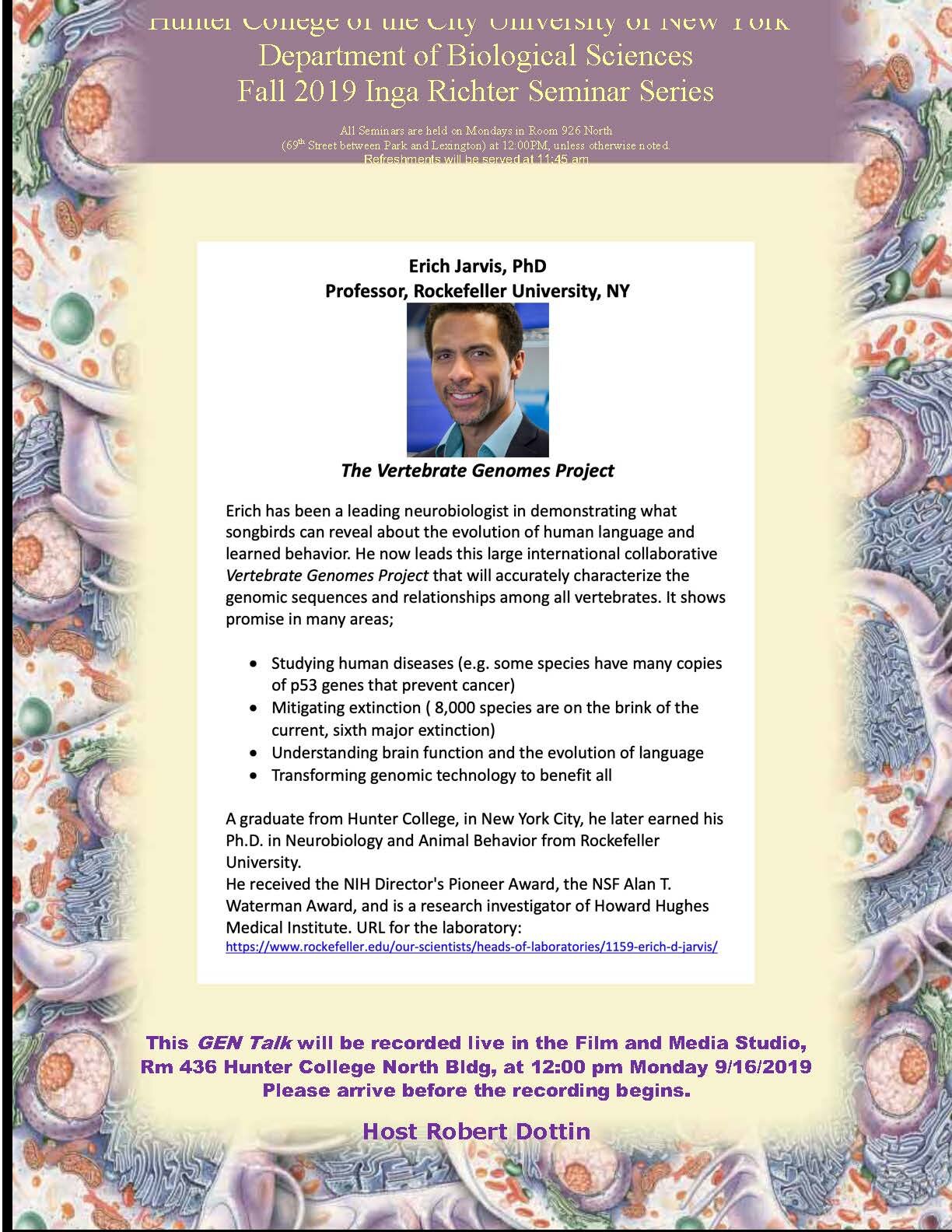Development and evolution of the neural crest in vertebrates.
Maria Elena de Bellar (Califonia State University, Northridge)
Monday, March 2nd, 12-1pm
Rm. 926, Hunter North
Development and evolution of the neural crest in vertebrates.
Maria Elena de Bellar (Califonia State University, Northridge)
Monday, March 2nd, 12-1pm
Rm. 926, Hunter North
Using the Force for Good and Evil: Force-induced Amyloids make Biofilms and Beer, and Redirect Innate Immunity.
Peter Lipke (Brooklyn College)
Monday, February 24, 12:00-1:00pm
Rm. 926 Hunter North
‘To go or not to go - Is that the question? The many faces of dopamine in learning and motivation.”
Peter Balsam (Barnard College - Columbia University)
Friday, February 21st, 10-11:30
The Graduate Center, Room 6496
Fifth Ave. and 34th Street
“Coping with Environmental Change: Integrating Behavior and Mechanism”
Dustin Rubenstein (Columbia University)
Friday 2/14, 10am, Room 6496
The Graduate Center @ Fifth Ave & 34th Street
“Value is in the eye of the beholder: visual attention and value signals in the primate orbitofrontal cortex.”
Vincent McGinty (Rutgers University - Newark)
Friday 2/7, 10-11:30am
The Graduate Center, 365 5th Ave (@ 34th St), Room C202
I’m looking forward to sharing our work on circuit communication during fear suppression at SUNY Albany, where I will tie together our older and newer work on this topic. We look at circuit communication in fear suppression during discrimination of a non-threatening cue, extinction of a threatening cue, and safety learning in order to have a thorough understanding of neural processing in emotion regulation.
Michael Beauchamp (Baylor College of Medicine)
Neural mechanisms for multisensory integration and visual perception in human subjects
10-11:30am, Rm. C198, The Graduate Center
Gap Junctions in the Nervous System: Composition and Plasticity of the Nexus
David Spray (Einstein School of Medicine)
Rm. 926 Hunter North, 12-1pm
Alfredo Fontanini (SUNY Stony Brook)
The role of gustatory insular cortex in taste, expectation, and decision making.
The Graduate Center, 34th St. & Fifth Ave., Room 9205, 10-11:30am
Psychology Seminar: Wed., 11/20, 12-1pm, HN612
Jeremy Barry (University of Vermont)
Where we are going and where we’ve been: The basic and translational science approach to understanding spatial memory
Place cells, grid cells, traveling waves, and memory: Probing memory and navigation with direct human brain recordings.
Joshua Jacobs (Columbia University)
CNC Neuroscience Seminar, Segal Theater, The Graduate Center (34th and Fifth Ave), 10-11:30 am
CNC Neuroscience Colloquium @ The Grad Center (34th & Fifth Ave, Room 6304.01), 10-11:30 am
Gamma oscillations in the basolateral amygdala: why, where, how, and what for.
Drew Headley, CMBN, Rutgers - Newark
We’re off to the Society for Neuroscience meeting in Chicago. If you’re at the meeting, you can find Becky presenting her collaborative work with Dr. Nesha Burghardt and our lab during Sunday’s morning poster session, and Carolina, Rebecca, and Itzik (showing his work done in collaboration with Dr. Tracy Dennis-Tiwary’s lab) in Tuesday’s afternoon session.
October 20, 8am - 12pm
151.15 Serotonin input to the dorsal BNST contributes to sex differences in fear learning
R. Ravenelle, H. Yoon, E. Likhtik, N.S. Burghardt
Tuesday, October 22, 1-5pm
593.22 Infralimbic projections to the basal forebrain regulate fear extinction recall.
C. Fernandes-Henriques*, R. Zhang-Shen*, I. Grunfeld, M.B. Corniquel, N. Burney, S.X. Lei, M. Labkovich, D. Semidey, E. Likhtik
593.23 Auditory safety training improves novel auditory discrimination learning and sensory discrimination curves.
I. Nahmoud, J.G. Vasquez, H. Cho, T. Dennis-Tiwary, E. Likhtik
This month’s issue of Nature Neuroscience focuses on Learning and Memory, hitting a lot of nails on the head around this sprawling topic - from Brain Machine Interfaces, to links between pain processing and learning, to sleep, to development, neurogenesis, and mechanisms of memory retrieval. In our review paper with Joshua Johansen (Riken), we focus on the variety of roles that the neuromodulators acetylcholine, noradrenaline, and dopamine play in circuit function during aversive emotional learning. We discuss how these different neuromodulatory systems can increase the gain of a signal, improving signal-to-noise during learning, how their modular organization allows for context-dependent learning modes, and how their patterns of innervation can bind distal regions during learning, when circuit communication incorporates new patterns of activity.

Christopher Mason (Weill Cornell)
The Genomics, Epigenomics, and Metagenomics of Human Spaceflight
Carolina joined the lab in May and just defended her First Exam, great work!
Here Carolina trains Rebecca how to dominate at foosball.

Data-driven multiscale modeling of cortical circuits, Salvatore Dura-Bernal (SUNY Downstate Medical Center)
The Graduate Center (34th St. & 5th Ave), Room 6304.01, 10-11:30am

Salvatore Dura-Bernal’s research focuses on understanding cortical circuits through large-scale biophysically-detailed simulations on supercomputers. He has developed the most detailed model of mouse primary motor cortex (M1) circuits by integrating experimental data available at multiple scales -- molecules, neurons, networks and systems. The model provides insights into cortical dynamics, physiological oscillations, information flow and molecular neuromodulatory mechanisms, which has helped develop new hypotheses and guide experimentation. He also developed a software tool (www.netpyne.org) for multiscale modeling of brain circuits. It has already been used worldwide in over 20 labs, to train students and to investigate different brain regions and phenomena. The tool can help to better understand neural brain function and disorders, and aid in developing novel pharmacological or neurostimulation treatments.
Moses Chao (NYU School of Medicine)
The Importance of Activity in the Nervous System
Friday, Sept. 20, 10-11:30, Rm. 6496

The Vertebrate Genomes Project, Eric Jarvis (Rockefeller University)
Room 436, Hunter North

Matthew Gardner (NIDA)
The Orbitofrontal Cortex and Economic Choice
Graduate Center, CUNY, Rm. 6496